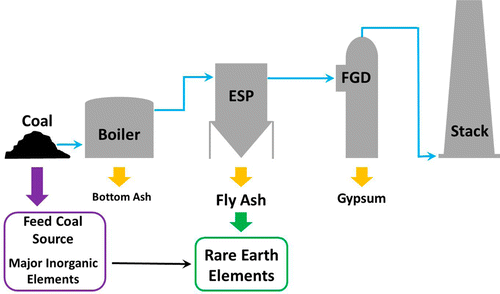The abstract of the article Trends in the Rare Earth Element Content of US-Based Coal Combustion Fly Ashes in Environmental Science and Technology notes “rare earth elements (REEs) are critical and strategic materials in the defense, energy, electronics, and automotive industries. The reclamation of REEs from coal combustion fly ash has been proposed as a way to supplement REE mining. However, the typical REE contents in coal fly ash, particularly in the US, have not been comprehensively documented or compared among the major types of coal feedstocks that determine fly ash composition.
The objective of this study was to characterize a broad selection of US fly ashes of varied geological origin in order to rank their potential for REE recovery. The total and nitric acid-extractable REE content for more than 100 ash samples were correlated with characteristics such as the major element content and coal basin to elucidate trends in REE enrichment. Average total REE content (defined as the sum of the lanthanides, yttrium, and scandium) for ashes derived from Appalachian sources was 591 mg kg–1 and significantly greater than in ashes from Illinois and Powder River basin coals (403 and 337 mg kg–1, respectively).
The fraction of critical REEs (Nd, Eu, Tb, Dy, Y, and Er) in the fly ashes was 34–38% of the total and considerably higher than in conventional ores (typically less than 15%). Powder River Basin ashes had the highest extractable REE content, with 70% of the total REE recovered by heated nitric acid digestion. This is likely due to the higher calcium content of Powder River Basin ashes, which enhances their solubility in nitric acid. Sc, Nd, and Dy were the major contributors to the total REE value in fly ash, based on their contents and recent market prices.
Overall, this study shows that coal fly ash production could provide a substantial domestic supply of REEs, but the feasibility of recovery depends on the development of extraction technologies that could be tailored to the major mineral content and origins of the feed coal for the ash.
The authors are Ross K. Taggart†, James C. Hower‡, Gary S. Dwyer§, and Heileen Hsu-Kim*†
†Department of Civil and Environmental Engineering and §Earth and Ocean Sciences Division, Nicholas School of the Environment, Duke University, Durham, North Carolina 27708, USA
‡ Center for Applied Energy Research, University of Kentucky, Lexington, Kentucky 40511, USA











